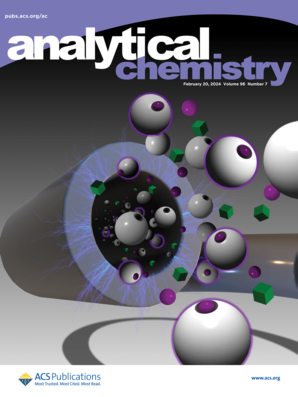Feeling of an Eye When It Meets the Unseen “Nano”
IF 6.7
1区 化学
Q1 CHEMISTRY, ANALYTICAL
引用次数: 0
Abstract
Nanomedicine is increasingly being utilized in addressing various eye ailments and holds immense potential in rectifying ocular diseases; however, the interactions between nanomedicines and their route of administration via tear fluid remain poorly understood. When nanoparticles are introduced into the tear fluid, a layer of protein corona is formed on their surface that not only influences the properties and biological fate of nanoparticles but also potentially interferes with the function of endogenous proteins. To investigate the interactions between gold nanoaprticles (AuNPs) and tear fluid, focusing on the physicochemical changes of the particles, and to quantitatively and qualitatively identify the key proteins involved in the corona formation, we employed label-free techniques for material and biophysical characterizations along with proteomic analyses and mass spectrometry. The AuNPs remained stable without forming aggregates, showing only an ∼31 nm increase in hydrodynamic diameter after interacting with tear fluid. Notably, their overall zeta potential increased significantly from −12 to −23 eV due to the supplemented charge by the adsorbed proteins. Proteomic analysis and liquid chromatography/mass spectrometry (LC-MS/MS) identified 31 proteins that were bound with the nanoparticles from a total of 174 proteins that were detected in the tear fluid. Bioinformatic classification revealed an enrichment of specific proteins essential for ocular health; proteins such as clusterin, lactotransferrin, adenosine triphosphate (ATP) synthase, lysozyme, alpha enolase, keratin, apolipoprotein, and epidermal growth factor receptor (EGFR) with pivotal roles in anti-inflammatory, immune response, cell adhesion, cellular organization, plasminogen activation, cell signaling, stress response, and corneal epithelial homeostasis. Overall, our study provides an unresolved comprehensive map of the tear protein corona landscape and its impact on nanoparticle behavior in the tear fluid. These insights must be considered and are valuable for designing safer and more effective nanomedicines for the treatment of various eye diseases.

当眼睛遇到看不见的“纳米”时的感觉
纳米医学越来越多地被用于治疗各种眼疾,在矫正眼疾方面具有巨大的潜力;然而,纳米药物之间的相互作用及其通过泪液给药的途径仍然知之甚少。当纳米颗粒被引入泪液时,在其表面形成一层蛋白质冠,这不仅影响纳米颗粒的性质和生物学命运,而且可能干扰内源性蛋白质的功能。为了研究金纳米颗粒(AuNPs)与泪液之间的相互作用,重点关注颗粒的物理化学变化,并定量和定性地鉴定参与电冕形成的关键蛋白质,我们采用无标记技术进行材料和生物物理表征,以及蛋白质组学分析和质谱分析。AuNPs保持稳定,没有形成聚集体,在与泪液相互作用后,水动力直径仅增加~ 31 nm。值得注意的是,由于吸附蛋白的补充电荷,它们的总zeta电位从- 12 eV显著增加到- 23 eV。蛋白质组学分析和液相色谱/质谱分析(LC-MS/MS)从泪液中检测到的174种蛋白质中鉴定出31种与纳米颗粒结合的蛋白质。生物信息学分类揭示了眼健康必需的特定蛋白质的富集;如聚簇蛋白、乳转铁蛋白、三磷酸腺苷(ATP)合成酶、溶菌酶、α烯醇酶、角蛋白、载脂蛋白和表皮生长因子受体(EGFR)等蛋白,它们在抗炎、免疫反应、细胞粘附、细胞组织、纤溶酶原激活、细胞信号传导、应激反应和角膜上皮稳态中起关键作用。总的来说,我们的研究提供了一个尚未解决的泪液蛋白冕景观及其对泪液中纳米颗粒行为影响的全面地图。必须考虑这些见解,并且它们对于设计用于治疗各种眼病的更安全、更有效的纳米药物很有价值。
本文章由计算机程序翻译,如有差异,请以英文原文为准。
求助全文
约1分钟内获得全文
求助全文
来源期刊

Analytical Chemistry
化学-分析化学
CiteScore
12.10
自引率
12.20%
发文量
1949
审稿时长
1.4 months
期刊介绍:
Analytical Chemistry, a peer-reviewed research journal, focuses on disseminating new and original knowledge across all branches of analytical chemistry. Fundamental articles may explore general principles of chemical measurement science and need not directly address existing or potential analytical methodology. They can be entirely theoretical or report experimental results. Contributions may cover various phases of analytical operations, including sampling, bioanalysis, electrochemistry, mass spectrometry, microscale and nanoscale systems, environmental analysis, separations, spectroscopy, chemical reactions and selectivity, instrumentation, imaging, surface analysis, and data processing. Papers discussing known analytical methods should present a significant, original application of the method, a notable improvement, or results on an important analyte.
 求助内容:
求助内容: 应助结果提醒方式:
应助结果提醒方式:


